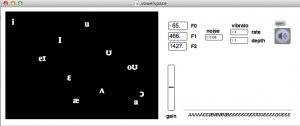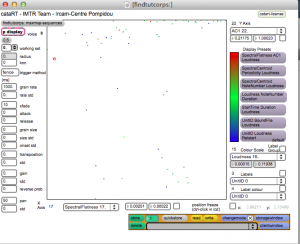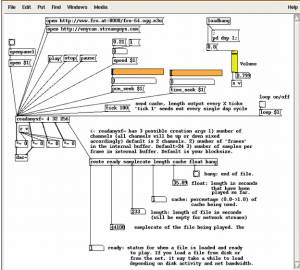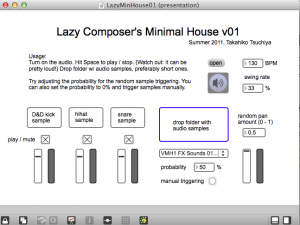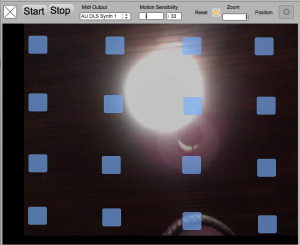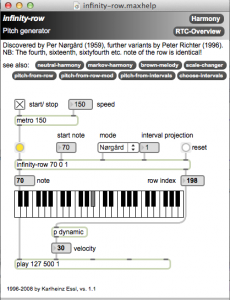Gabor from IRCAM

notes
Multi-representation overlap-add signal processing. Possibly good for speech synthesis in Max http://ftm.ircam.fr/index.php/Gabor
Also, an excellent pitch tracking object.
vowel space by Ben Guo
cataRT tutorial 1-2 instructions
CataRt is a visual granular synthesizer project from IRCAM. These are some instructions to get started. I’m really not sure what its doing, but it reorganizes clips of sound into scatter diagrams that you can play by intersecting with the mouse. It would be interesting to try this program with Mira – but I think its using an external object that Mira doesn’t understand.
download/install
- Install latest version of FTM (from IRCAM) that you can find – I installed FTM 2.6.0 beta
- Download latest version of cataRT and move it somewhere
- add the file path to main folder to max file preferences
- The example below is tutorial 1-2 in the tutorials folder
instructions
- turn up the volume
- click the import maxmsp sequences message
- click the find-units-within-pitch message
- double click the catart.lcd findtutcorps abstraction (outlined in pink)
- move the mouse around in the lcd to play various sounds
- try configurations on the right sidebar
Non-blocking audio file read in Puredata
notes
http://puredata.info/downloads/readanysf
Also found these, but development appears to have stopped
threadlib: http://grh.mur.at/software/threadlib.html
sndfile http://grh.mur.at/software/sndfiler.html
Note: Haven’t tested either of these. The discussion on the forums indicates that there are potential unresolved problems.
infinity series by Per Nørgård
From Wikipedia: http://en.wikipedia.org/wiki/Per_Nørgård
Nørgård’s music often features the use of the infinity series (DanishUendelighedsrækken) for serializing melody, harmony, and rhythm in musical composition. The method takes its name from the endlessly self-similar nature of the resulting musical material,[1] comparable to fractal geometry. Mathematically, the infinity series is an integer sequence. The first few terms of its simplest form are 0, 1, −1, 2, 1, 0, −2, 3, … (sequence A004718 in OEIS).
Nørgård discovered the melodic infinity series in 1959 and it proved an inspiration for many of his works during the 1960s. However, it was not until his Voyage into the Golden Screen for small ensemble (1968)—which has been identified as the first “properly instrumental piece of spectral composition” (Anderson 2000, 14)—and Symphony No. 2 (1970) that it provided the structure for an entire work (Nørgård 1975, 9). The harmonic and rhythmic infinity series were developed in the early 1970s and the three series were first integrated in Nørgård’s Symphony No. 3.
more information
Lyrebird and Acoustic Guitar
An audio filter that extracts music from noise.
by Chris Lopez
Probability based drum sequencer by Takahiko Tsuchiya
Sound Emotion2
infinity-row
by Karlheinz Essl at rtc-lib
http://www.essl.at/works/rtc.html
Local file: RTC-lib_50_2/put content into patches/RTC-lib/RTC-lib Help/Harmony/infinity-row.maxhelp


